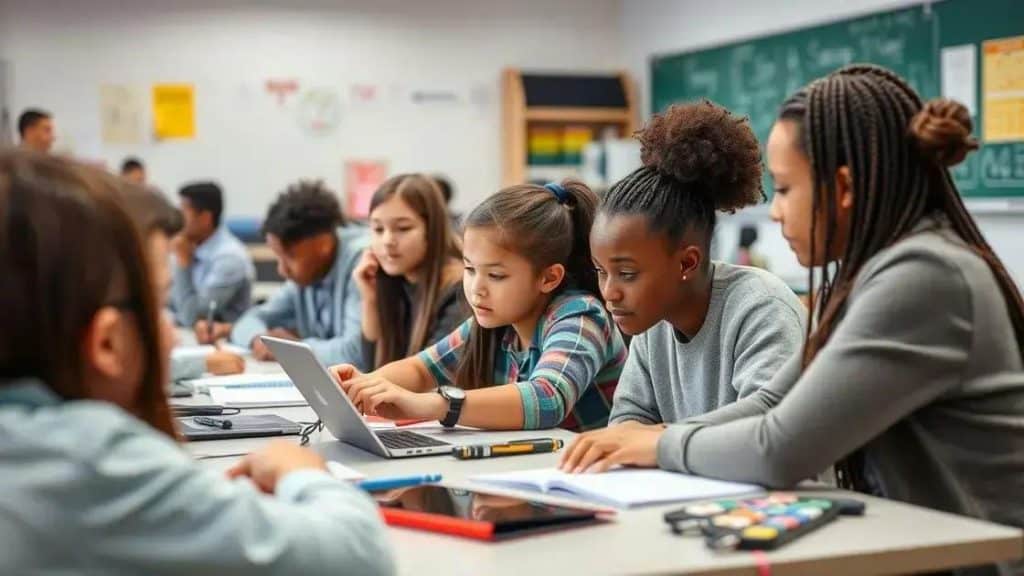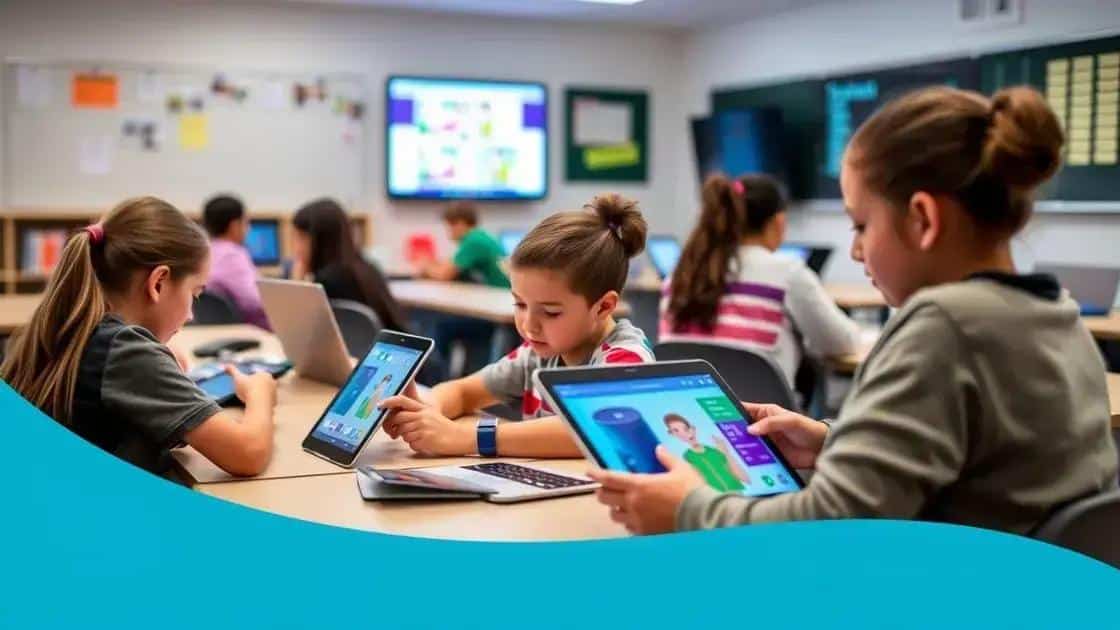Patterns in academic success 2025 impact on students

Patterns in academic success can be improved through data-driven strategies, a holistic approach to education, and the effective integration of technology, ensuring that students achieve optimal learning outcomes.
Patterns in academic success 2025 impact are shaping the landscape of education. Have you noticed how different strategies influence learning? In this article, let’s dive into these trends and explore their significance for students and schools.
Understanding academic success patterns
Understanding academic success patterns is crucial for improving student outcomes. These patterns reveal how different factors contribute to effective learning and achievement. By examining these elements, educators can implement strategies that enhance student performance.
Key Elements of Academic Success
Several factors influence academic success. These include:
- Effective study habits: Habits like time management and regular review can greatly affect learning.
- Support systems: Emotional and academic support from teachers and peers can motivate students.
- Active engagement: Participation in class discussions and activities leads to deeper understanding.
Apart from these elements, it’s important to recognize how individual differences in students play a role in their success. For instance, some students may thrive in collaborative settings, while others may excel when studying alone. Understanding these preferences can help tailor approaches to meet diverse needs.
Impact of Environment on Learning
The learning environment significantly impacts academic success patterns. A positive, encouraging atmosphere fosters confidence and curiosity in students. Schools that provide resources—like access to technology and counseling—create conducive conditions for learning.
Moreover, family involvement is a critical aspect of a student’s educational journey. When parents engage with their child’s education, it instills a value for learning and encourages perseverance.
As we examine these success patterns, we can see that they are interconnected. Addressing one factor often influences others. Therefore, a holistic approach is essential.
Recognizing these dynamics can equip educators to create innovative strategies that foster student success. Schools can introduce mentoring programs, resource centers, and inclusive curriculum designs that cater to various learning styles.
Key factors influencing student performance
The key factors influencing student performance are essential for understanding how to help students succeed. Identifying these factors can lead to targeted strategies that enhance learning experiences.
Academic Environment
A supportive and structured academic environment plays a vital role. When students feel safe and encouraged, they tend to perform better. Several aspects contribute to this environment:
- Motivating teachers: Engaging educators inspire students to strive for excellence.
- Peer relationships: Positive interactions among students foster collaboration and support.
- Resource availability: Access to learning materials and technology enhances understanding.
Many students find that a positive classroom culture encourages them to participate more actively in their learning. This leads to not only better grades but also greater retention of knowledge.
Individual Factors
Individual traits also play a significant role in academic success. Each student’s background and personal skills contribute to their learning journey. Some of the individual factors include:
- Learning styles: Different students absorb information differently; some may prefer visual aids while others benefit from hands-on experiences.
- Self-discipline: Students with strong self-discipline often achieve higher academic performance.
- Goal orientation: Those who set clear academic goals are likely to strive harder to achieve them.
When students engage actively in setting their own goals, they often demonstrate improved focus and achievement. This personal investment in their education encourages a lifelong love for learning.
Lastly, the influence of external factors such as family support, social expectations, and community resources cannot be understated. Involvement from family and community instills a sense of responsibility and motivation in students, further boosting their performance.
The role of technology in education

The role of technology in education has transformed how students learn and interact in the classroom. With the integration of various technological tools, educators can enhance the learning experience significantly.
Interactive Learning Tools
One of the most exciting advancements is the use of interactive learning tools. These tools engage students and encourage participation. Here are some examples:
- Smartboards: These allow teachers to present interactive lessons that students can participate in directly.
- Educational apps: Many apps promote learning through games, quizzes, and interactive activities.
- Virtual simulations: Students can explore complex concepts in a fun and engaging way.
When students can actively participate using these tools, they often retain information better and feel more connected to the material.
Online Learning Platforms
Online learning platforms have also changed educational landscapes. These platforms provide flexibility and accessibility for all students. They can access resources anywhere, anytime, which is particularly beneficial for those with different learning paces.
Some key features of online platforms include:
- Video lectures: These allow students to learn at their own pace and revisit difficult concepts.
- Discussion forums: Students can collaborate and discuss ideas, enhancing understanding through peer interaction.
- Personalized feedback: Many systems provide tailored feedback to help students improve.
This access can foster independent learning and self-motivation, as students take charge of their educational journeys.
Moreover, technology provides resources that support diverse learning styles. From visual aids to auditory resources, technology caters to various preferences and needs, ensuring that all students have the opportunity to succeed.
Strategies for improving academic outcomes
Implementing effective strategies for improving academic outcomes is essential for both teachers and students. By focusing on tailored approaches, educators can help students achieve their full potential.
Active Learning Techniques
One of the most beneficial strategies is incorporating active learning techniques in the classroom. These methods encourage student participation and engagement. Some effective techniques include:
- Group discussions: Students express ideas and learn from peers.
- Hands-on projects: Real-world applications help students understand concepts better.
- Peer teaching: Students explain topics to each other, reinforcing their understanding.
When students are actively involved in their learning, they tend to retain information longer and develop critical thinking skills.
Regular Feedback
Another important strategy is providing regular feedback. Feedback helps students understand their strengths and areas for improvement. Timely comments can motivate students to keep trying. Some effective methods for giving feedback include:
- Written comments: Personalized notes on assignments can guide students.
- Verbal feedback: Direct conversations can clarify misunderstandings quickly.
- Self-assessment: Encouraging students to reflect on their work promotes self-awareness.
Such interactions not only support growth but also build a trusting relationship between students and educators.
Additionally, fostering a growth mindset is crucial for academic success. When students believe they can improve through effort, they are more likely to embrace challenges. Encouraging students to set realistic goals can help build this mindset and push them to achieve more.
Moreover, incorporating technology effectively can enhance learning experiences. Utilizing interactive tools and online resources provides diverse ways for students to engage with the material.
Future trends in educational success metrics
Understanding future trends in educational success metrics is vital for adapting to the evolving landscape of education. As technology and methodologies change, so do the ways we measure success for students and schools.
Data-Driven Decision Making
One major trend is the increased use of data for decision-making. Schools are beginning to rely on data analytics to gauge student performance more effectively. This allows educators to identify patterns and adjust their teaching strategies accordingly. Some examples include:
- Learning analytics: Analyzing data from students’ online activities to assess engagement.
- Predictive analytics: Using data to anticipate student outcomes and tailor interventions.
- Real-time feedback: Immediate insights through assessments and quizzes help in timely adjustments to teaching.
The shift toward data-driven methods empowers educators to create personalized learning experiences that cater to each student’s needs.
Holistic Approaches
Another trend is the shift towards more holistic success metrics. Schools are recognizing that academic success is not just about grades. Social-emotional learning (SEL) and mental health are becoming significant factors in evaluating educational success. Schools are implementing:
- SEL programs: Incorporating lessons on emotional awareness and interpersonal skills.
- Wellness assessments: Regular check-ins on students’ mental health and well-being.
- Community involvement: Engaging families and communities in the educational process.
By prioritizing holistic development, students are better equipped to face academic challenges and thrive in their personal lives.
As we look ahead, we can also expect innovations in technology that facilitate remote and hybrid learning environments. Tools that track student engagement and progress in virtual settings will become essential. This will allow for a more comprehensive understanding of how students learn in diverse contexts.
FAQ – Frequently Asked Questions About Educational Success Metrics
What are educational success metrics?
Educational success metrics are measurements used to gauge student performance, engagement, and overall educational effectiveness.
How can data analytics improve student outcomes?
Data analytics can identify trends and patterns in student performance, allowing educators to tailor instruction and provide targeted support.
What does a holistic approach to education involve?
A holistic approach includes addressing social, emotional, and academic needs, ensuring that students develop well-rounded skills.
Why is technology important in education?
Technology enhances learning experiences by providing interactive tools and resources that engage students and support diverse learning styles.





